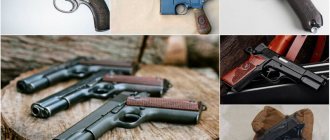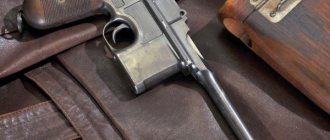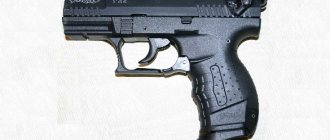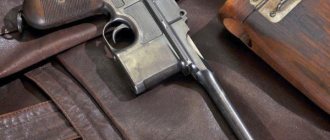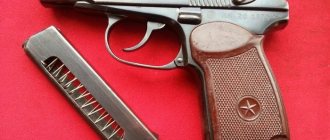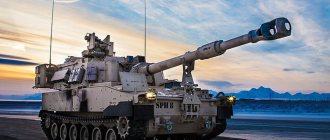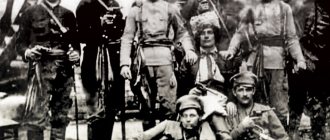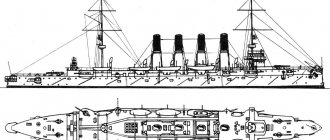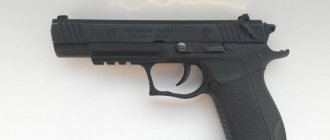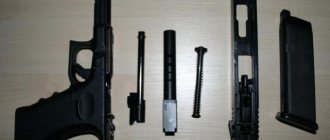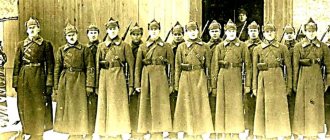Home | Weapons | Pistols | Germany | Mauser C-96
The design of the Mauser C-96 pistol was developed in 1893 by brothers Fidel, Friedrich and Josef Feederle (Fidel, Friedrich, Josef Feederle) and improved together with Paul Mauser and gunsmith Gaiser. The finishing work was completed in 1895. At the same time, production of a trial batch began. On March 15, 1895, the pistol was demonstrated to Kaiser Wilhelm II. Paul Mauser patented the design in his name, receiving Reichspatent No. 90430 on September 11, 1895. Another patent was received in the UK. The official name of the pistol, given by it, which translated means “Self-loading Mauser pistol.” Since the beginning of production in 1910 of the pocket Mauser chambered for 6.35x15.5 HR, the pistol began to be called “C-96” (Construktion 96 - design of the 96th year). It should be clarified that this name was used only by sellers and importers. At the Mauser company, the pistol was still called the “Mauser-Selbstlade-Pistole”. Another official name is Model 1930. Other modifications have unofficial names, for example “Model 1912” or “Bolo”.
The new weapon had several distinctive features. A permanent double-row magazine with a capacity of 10 rounds was placed in front of the trigger guard and was loaded with cartridges from plate clips. The pistol was held using a round conical handle with grooves for attaching a wooden butt holster. The C-96 received the nickname "Broomhandle", which means "broom handle", precisely because of the shape of the handle. The sector sight was designed for shooting up to 1000 meters. For this pistol, a new 7.63x25 Mauser cartridge was developed, the design of which was based on the 7.65 mm Borchardt cartridge, but with an elongated sleeve and an increased powder charge. The initial bullet speed was 430 m/s, which was a record among pistols of that time. In addition, Mausers were produced chambered for 9mm Parabellum and, in small quantities, chambered for 9mm Mauser Export (9×25).
Paul Mauser
Mauser Model 1895 pistol
Mauser "Cone Hammer" pistol
Before considering the design and history of this weapon, let's take a look at the various versions of the pistol. Waffenfabrik Mauser AG has repeatedly upgraded the C-96 design, subjecting it to a variety of, usually minor, changes. The largest number of modifications were created in the early period of production - from 1896 to 1905. They changed the length of the barrel, the capacity and shape of the magazine, the shape of the handle, the shape of the trigger, the grooves on the frame and the external finish. Some variants differ only in the location of the serial number. In total, collectors counted more than 130 different versions of the Mauser-Selbstlade-Pistole. The most popular type of early release is the model with a conical hammer, the so-called “Cone Hammer”. The main distinguishing feature is the trigger with conical cheeks. The pistol was produced with a 10-round magazine, a 140 mm barrel, and a sector sight marked at a distance of 50 to 1000 meters. There are also pistols with magazines with a capacity of 6 and 20 rounds. Approximately 16,000 Cone Hammer pistols were produced.
The next popular option from the early release is a model with a large hole trigger. It was called the “Large Ring Hammer,” which means “Trigger with a large ring.” The released trigger blocked the aiming line. Most of the options belong to this variety. The most popular of them is the “Flat Side” pistol, commissioned by the Italian Navy. The model received this name because of the flat side surfaces of the frame, without milled grooves. During this period, the first shortened versions appeared with a smaller handle, a 100 mm barrel and a magazine with a capacity of 6 rounds. In total, about 25,000 copies of the Large Ring type pistols were produced.
Mauser C-96 “Large Ring Hammer” pistol, 1899
Mauser “Large Ring Hammer” in the “Flat Side” version, commissioned by the Italian Navy
Mauser "Small Ring Hammer" pistol
By 1905, pistol production had stabilized in terms of variations. Now only two main modifications were produced - full-size and shortened pistols. The exception was the release of a small number of full-size pistols chambered for the 9mm Mauser Export cartridge. One of the most famous pre-war versions was a pistol with a hammer with a small hole, called the “Small Ring Hammer”. In addition to the trigger with a “small ring,” the weapon received a slightly modified safety lock. In early models, such as the Tapered Trigger or the Big Ring Trigger, the safety lever's top position is on and the safety lever's bottom position is off. The "small ring trigger" and all later models have a reverse safety. In addition, the long ejector used in early models has been replaced with a short one.
Issued between 1912 and 1918. pistols are classified as military issue. The reason is that in 1912 a new safety design was introduced - “Neue Sicherung”, and it is impossible to determine by the number whether such a pistol was produced in 1912 or 1915 due to the lack of archives. The new fuse was abbreviated as "NS". This monogram was made on the back surface of the trigger. The fuse head is made without a through hole. On the scope of the “Small Ring” models with the “Neue Sicherung” fuse, they did not put an o. About 130,000 of these pistols were produced.
C-96 with "Neue Sicherung" fuse (Model 1912) Photo (c) ygran.ru
Mauser C-96 “Red Nine” pistol with attached holster-stock
The Mauser C-96 “Red Nine” pistol is a conversion of the standard 9mm Parabellum cartridge, distinguished by large numbers “9”, with red paint, on the sides of the grip cheeks
In 1916, Prussia placed an order with Waffenfabrik Mauser AG for 150,000 pistols chambered for the standard 9mm Parabellum cartridge. This version of the 96th was later called the “Red Nine” (Red Nine) for the large number “9”, painted over with red varnish, present on the cheeks of the handle of these pistols, so that they could be easily visually distinguished from weapons of 7.63 caliber mm. In addition to the caliber, these pistols were distinguished by a sight marked from 50 to 500 meters. The stamp of the Prussian Army Reception Commission was placed on the right side of the chamber. After 1917, such pistols were equipped with a recess in the feeder for greater operational reliability. It should be noted here that after World War II, a large number of 7.63 mm pistols were converted to the 9 mm cartridge. Pistols issued under the Prussian Contract are distinguished by the mark of the Army Acceptance Committee on the right side of the chamber, the hammer with the stamp “NS” and “Small Ring”, as well as walnut cheeks with 24 grooves and a carved “9”.
Models of the post-war period include pistols produced from 1920 to 1937. The earliest version of the post-war Mauser is the Model 1920. In the conditions of post-war devastation in Germany in the 1918-1920s, Mauser factories did not produce their famous pistols, but from 1920 they began to remake old pistols for the police. Under the terms of the Versailles Peace Treaty of 1919, Germany was prohibited from producing pistols with a barrel length of more than 100 mm and a caliber of more than 8 mm. As a result, a wide variety of C-96 variants were redesigned by shortening the barrel. Such pistols can be distinguished by their 99 mm long barrel and the “1920” stamp on the receiver or frame. But a small number of 7.63 mm and 9 mm pistols with 140 mm barrels were also produced. Sometimes a P.08 type front sight was attached to the cut barrel. The “Red Nines” were also redesigned by installing a 99 mm barrel of 7.63 mm caliber, as well as a non-adjustable rear sight instead of the one marked up to 500 meters.
Mauser of the post-war period, manufactured in 1920, with a 99 mm long barrel and the stamp “1920”, converted from a “Red Nine” pistol of the Prussian order
Mauser “Bolo” with a pack of 7.63×25 cartridges and clips
One of the most famous variants of the shortened C-96 was the Mauser "Bolo". In 1922, Mauser again began production of a shortened version of the C-96. The largest customer of such Mausers was Soviet Russia. Two batches of 5,000 and 15,000 copies were purchased, which were used by the NKVD and the Red Army. Such pistols are distinguished by 99 mm long barrels, 7.63 mm caliber, a shortened handle with walnut cheeks with 22 grooves, and a “Small Ring Hammer” trigger with the “NS” stamp. But the main difference between the post-war shortened Bolo Mausers is the horizontally swinging swivel on the handle.
The Model 1930 is the only C-96 pistol to have its own name given to it by its manufacturer. This variant began to be produced in 1930 after the production of the shortened "Bolo" ceased. To reduce production costs, as well as increase reliability and safety, a number of changes were made to the design of this weapon. Initially, the pistols were equipped with 132 mm long barrels, but then returned to the classic 140 mm barrel. The Model 1930 can be easily identified by the transition on the barrel with a thicker chamber area. The pistol received a new design fuse, which, when turned on, safely released the hammer from cocking, without contact with the firing pin. The shape of the “Small Ring Hammer” trigger also underwent changes, from which the grooves around the hole, the number and the “NS” mark were removed. The frame was made without a step for the cheeks of the handle. The cheeks themselves now had 12 deep grooves. The swivel is fixed, swinging not back and forth, but from side to side, like a “Bolo”. The labeling has changed. On the right side of the frame was the inscription: “WAFFENFABRIK MAUSER OBERNDORF A. NECKAR DRPuAP.” Due to large deliveries of this option to China, on the left side of the store, in the lower part, they placed a stamp with hieroglyphs meaning “Made in Germany.”
Mauser Model 1930 pistol
Mauser pistol-carbine made on the basis of the “Cone Hammer” variant
In addition to the standard full-size and shortened versions of the C-96, so-called pistol-carbines were also produced. The first of them was made in 1899. The main difference was the 300 mm long barrel. The first pistol-carbines were produced based on the Cone Hammer models. Later they began to use the “Large Ring” option. Such pistol-carbines had a fore-end and a classic-type butt attached to the frame. The butt, made integral with the handle, was completely separated from the frame, since pistols with attached butts or folding guns were allowed under the German weapons legislation of that time, carbines and rifles that could be fired with them removed were prohibited. This weapon, based on the Large Ring pistols, was produced in a limited edition of 800 copies until 1905. In 1907, the manufacturer tried to resume production of carbine pistols, but with a “Small Ring Hammer” type trigger and a new type of safety. However, after 140 copies were produced with a barrel length of 300 mm and a “Flat Side” frame, their production was completely discontinued. All original pistol-carbines produced by Mauser have such features as a removable stock with a handle, without the ability to fire a shot without an attached stock, a permanent magazine for 10 rounds of 7.63×25, barrels 300 mm or 370 mm long, a sector sight with markings from 50 to 1000 meters.
Production of the Mauser C-96 pistols ceased in 1937, mainly for two reasons. The first is the beginning of the Sino-Japanese War, since China, which was the main customer, stopped purchasing these pistols. The second reason is a large government order for 98k carbines and P.08 pistols. However, after the Mauser factories in Germany ceased production, pistols of the C-96 type were produced for a long time in Spain. China produced its own pistols of this type right up to the 1980s.
The Mauser had very high combat qualities for pistols of its time, but was not adopted by more than one army in the world due to its high cost, complexity of design and maintenance, relatively low reliability, as well as large dimensions, but, nevertheless, it was partially used in the armed forces of Germany, Italy, Yugoslavia, Great Britain, Russia, Japan, Turkey and China. The pistol was destined for a slightly different role in world history than just a military weapon. But first, let's look at the design.
Commercial version of the Mauser C-96 pistol (Mauser-Selbstlade-Pistole) chambered for a very powerful 9mm Mauser Export cartridge
Cartridges used in the Mauser C-96 pistols: 9mm Parabellum, 7.63mm Mauser and 9mm Mauser Export (from left to right)
The automation works according to the scheme of using recoil with a short barrel stroke. Locking is carried out using a combat cylinder that rotates in a vertical plane when interacting with elements of the pistol frame. The larva is connected to a movable receiver, in the front of which the barrel is fixed. The bolt moves inside the receiver. When the barrel-receiver-bolt system moves backward, the cylinder lowers and releases the bolt. While moving back, the bolt removes the spent cartridge case from the chamber, ejects it and cocks the hammer. When the system returns to the forward position, the bolt sends the next cartridge from the magazine into the chamber, and the larva interacts with the frame protrusion, rises and engages the bolt with the lugs. The trigger mechanism is hammer type, single action, with an open trigger. To the left of the hammer is a safety lever, which in early models blocked the hammer in the cocked or deflated position, and in the 1912 model - only in the cocked position. When all the cartridges are used up, the bolt stops at the bolt stop in the rearmost position. A distinctive feature of the pistol is a permanent magazine with a double-row arrangement of cartridges, located in front of the trigger guard, made as a single unit with the frame.
The magazine capacity was different, depending on the modification - 6, 10 or 20 rounds. The magazine was loaded from clips with a capacity of 10 rounds. In later models, the magazines became separate parts and were attached to the frame with a latch. The presence of a cartridge in the chamber is indicated by the ejector, which protrudes from the surface of the bolt when the cartridge is in the chamber. The sector sight is designed for a firing range of up to 1000 meters. This calculated range is excessively excessive, since, despite the full power of the cartridge used and the long barrel, in relation to pistols, accurate shooting, even with an attached holster-butt, beyond 100 - 150 meters becomes very problematic. In almost ideal conditions of absence of wind and other factors negatively affecting shooting accuracy, at a distance of 1000 meters the dispersion exceeded 5 meters in height and 4 in width. At 100 meters it is still possible to regularly “lay” all the bullets into a silhouette, but at 200 this will no longer be possible. The best results when shooting at a distance of up to 100 meters are a group of hits with a diameter of 300 mm. According to other sources, it was even possible to achieve a group with a diameter of 150 mm.
A wooden butt holster can be attached to the pistol handle, in which the weapon can be stored when carried. This holster-stock was the only means of allowing accurate fire from this weapon over long distances without the use of a rest. For its time, C-96 pistols were very reliable weapons compared to the first self-loading pistols, and their service life is the reason that they are used even today. Here is evidence from those years about the Mauser tests: “Mr. Commercial Advisor Mauser fired his pistol with a recoil of 6, 10, and 20 rounds at His Excellency Württemberg Minister of Defense Schult von Schottenstein in the Stuttgart shooting range 1000 shots in the presence of many generals, and everyone spoke out very commendable about this weapon.” During testing of one of the first C-96s, more than 10,000 rounds were fired: “Without any damage or noticeable wear to the working parts, and accuracy changed slightly.”
But let's not forget that the C-96 was created at the dawn of the era of self-loading pistols and simply could not be perfect in everything; of course, it had quite a few negative qualities. The Mauser is a very complex pistol in design. But an even greater difficulty was the manufacture of its parts of complex shape. The production of these weapons was very expensive. The complexity and high cost, as well as the need to constantly care for the weapon and monitor its condition, which required a lot of time and skill, were the reasons that the C-96 was not adopted by any army in the world in full. But, nevertheless, Mausers were used in the armed forces of several European powers. This was facilitated by one very significant circumstance at that time - then there was no intermediate weapon between long-range, long rifles, which, however, had a low rate of fire and maneuverability, and short-barreled personal weapons - pistols and revolvers, which were distinguished by maneuverability and convenience, but had a short firing range and, again but, as a rule, a low rate of fire. There were no submachine guns at the beginning of the 20th century. Shortened rifles and carbines did not save the situation either. And here the Mauser came in handy. Quite compact, smaller and more convenient than carbines, it had a high rate of fire and shot accurately, at fairly large distances, unattainable for conventional revolvers and the first pistols. It could be successfully used by cavalrymen, signalmen, artillerymen and reconnaissance officers.
Mauser "Model 1912" with "Neue Sicherung" fuse
The first war in which this legendary pistol took part was the Boer War of 1899 - 1902. Mausers then used both sides. The Boers willingly fought them, preferring the C-96 to the old revolvers. English officers bought these pistols with their own money. It is significant that the C-96 was the favorite weapon of the future British Prime Minister W. Churchill. According to legend, during the Sudan campaign, in the Battle of Omdurman (September 1898), the patrol of the 21st Hussar Regiment, led by 25-year-old Lieutenant Churchill, was surrounded by an enemy superior in manpower, but armed mainly with cold steel. In that battle, German pistols from Waffenfabrik Mauser AG played an important role. Subsequently, Churchill began collecting Mausers. The Italian Navy became one of the buyers of the C-96. A contract was signed with the Mauser company for the manufacture and supply of one thousand early model 7.63×25 pistols with a conical hammer to the Turkish army. The contract was fulfilled in full. Mausers were supplied in large quantities to China, where mass production of their copies was launched, including those chambered for .45 ACP cartridges.
During World War I, the C-96 was used by German forces as a limited standard weapon in trench warfare alongside the standard Parabellum. As mentioned above, Mauser pistols, called “Red Nine,” were chambered for the standard 9mm Parabellum cartridge. In total, about 130,000 of these pistols were produced. During combat use, the P.08 then established itself as a more reliable pistol, easier to disassemble and reassemble, clean and lubricate, and more practical in field conditions.
Lieutenant Busch of the 4th Royal Bavarian Infantry Regiment with a C-96
WWI soldiers with Mauser C-96 pistols
However, Mausers were in stable demand in the civilian arms market at that time. The reason for the popularity of these, in general, large and heavy pistols, poorly suited for long-term carrying, was their fighting qualities. The Mauser could quickly fire ten shots in a row. And if it was possible to aim, then make these shots with high accuracy over a distance that was quite large for ordinary pistols and revolvers of that time. Where a rifle was a burdensome weapon, the C-96 was an excellent replacement. It was used everywhere. Hunters who went after a wide variety of prey took advantage of the accuracy and rate of fire of the Mauser. Although 7.63 mm pistol bullets were not suitable for shooting large animals, there was even a recorded case of a rhinoceros being killed from a Mauser. By the way, according to Russian statistics on cases of self-defense against bears using pistols in the 20th century, the 7.63 mm Mauser cartridge was among the most effective ammunition, which also included 9mm Parabellum and .45 ACP. Interestingly, the effectiveness of shooting bears of these three calibers was approximately the same.
At the turn of the 19th and 20th centuries, research expeditions to distant countries in Africa and Asia, to little-explored and dangerous areas of the Earth, were popular. Rifles and carbines were too inconvenient and burdensome weapons for long campaigns and, moreover, did not have the necessary fighting qualities for weapons of maneuverable, fleeting close combat. Travelers, explorers and scientists needed fast-firing, lightweight and fairly compact weapons. They chose the Mauser C-96, with which pioneers mapped uncharted corners of the Earth, paleontologists unearthed ancient fossils of dinosaur bones in virtually deserted mountains and deserts, zoologists studied the fauna of exotic countries, and gold miners hunted for the precious metal. This circumstance helped create the image of a “miracle pistol-carbine” for brave adventurers. Although it is necessary to clarify here that Georg Luger’s carbine pistols were also very popular among travelers and hunters. However, the reason for the great demand in the civilian arms market for C-96 pistols was another circumstance - the Mauser is very interesting to simply shoot, which was used by sports shooters and just shooting enthusiasts.
Early Mauser Model 1930 pistol
The Mauser was truly an advanced pistol for its time. A powerful cartridge with high energy and high muzzle velocity, combined with a long barrel, ensured high penetration. When shooting at 50 meters, the bullet pierced a pine beam 225 mm thick, and at a distance of 200 meters - 145 mm timber. The weapon had excellent shooting accuracy over long distances, which was greatly facilitated by the flat trajectory of the bullet and, again, a fairly long barrel. A big plus was the high rate of fire, especially with the attached holster-stock. Of course, the gun also had its drawbacks. The most significant of them are large dimensions and heavy weight. The center of gravity is shifted forward. The thin and sharp front sight is not convenient when aiming. High-speed shooting with one hand is very problematic due to the large toss during the shot, which occurs not only due to the power of the cartridge, but also due to the significant distance between the butt plate of the handle and the central axis of the barrel. The handle, similar to the handle of a shovel or broom, does not spoil the owner with comfort and stability of holding, which again negatively affects accuracy. During high-speed shooting, the barrel quickly heated up. After shooting 20 rounds, the barrel already heats up quite strongly, and after 100, it’s almost impossible to touch it. The problem was also the large spread when firing bursts from automatic models. However, all these shortcomings did not prevent the Mauser from becoming a legendary weapon.
Mauser C-96 pistols first appeared in Russia in 1897, entering the list of personal weapons recommended for purchase by officers of the tsarist army. The aeronautical unit of the Main Directorate of the General Staff of the Russian Imperial Army adopted Mauser pistols in 1913, with two hundred cartridges for each of them, “as an accessory for airplanes.” In old Soviet films about the Civil War of 1917 - 1923. very often you can see a large wooden butt holster with a Mauser pistol inside. Moreover, these weapons were used by all the warring parties - both “red” and “white”. The Mauser was worn by both commissars and security officers, as well as the White Guards who opposed the Red Army. What was shown in the films was close to reality. During the Civil War, Mausers entered the country as aid supplied by the Entente countries to the White Guards. Captured C-96s were readily used by everyone who took part in the war at that time.
Pistol Mauser C-96 "Bolo"
Later, in 1926 - 1930. To arm the Cheka-OGPU and the Red Army, shortened versions of the Mauser were purchased from the Germans, which were produced in accordance with the restrictions of the Versailles Peace Treaty on the production of weapons in Germany - pistols had a caliber of less than 8 mm and a barrel shorter than 100 mm. These “civilian” and “police” models also differed in their shortened handles. Such pistols, produced until the early 1930s, were later called Mauser Bolo, that is, “Bolshevik” in Western countries. Mausers soon became the weapon of choice for a variety of bandits and terrorist groups. He was especially loved by anarchists and radical Socialist Revolutionaries. Moscow, St. Petersburg and Odessa criminals operated with Mausers. In Central Asia, these weapons were used by the Basmachi, whose leaders used the C-96 as a symbol of authority and power, along with daggers and sabers made of Damascus steel.
The Mauser is inextricably linked with the image of a security officer in a leather jacket and a Soviet commissar. The C-96 was Iron Felix's weapon of choice. Later, Mauser became a symbol not only of the Bolsheviks, but also of all independence fighters, revolutionaries and rebels in general. This heavy and powerful pistol has become a symbol of the brave warrior's personal combat weapon. After the Civil War, Mausers became a fairly widespread weapon, both among security officers and commanders of the Red Army. In the 1920s, the Podolsk cartridge plant produced 7.63x25 cartridges for these pistols. This fact, together with extensive combat experience in using the C-96, became one of the decisive circumstances for the adoption of the 7.62x25 cartridge for the TT pistol and Degtyarev and Shpagin submachine guns in 1930 by the Red Army. The Soviet cartridge differed only slightly from the German one; these cartridges are interchangeable.
Chinese Kuomintang volunteers with Mausers
In this World War II photo, Chinese infantrymen who specialized in close combat are armed with traditional Dao swords and Mauser C-96 pistols
From the time of the Russian Civil War until the start of World War II, the C-96 managed to take part in several more military conflicts. They were used by the Spanish gendarmerie, who fought on the side of the right-wing nationalists under the command of General Francisco Franco against the Republicans during the Spanish Civil War. With the help of these long-range pistols, the gendarmes easily destroyed the enemy armed with hunting rifles, revolvers and compact pistols, and during street battles the Mausers performed well against fighters with long rifles. In the USSR, C-96 pistols, which accumulated in fairly large quantities in the first two decades of the 20th century, were still sometimes found in the Red Army and managed to occasionally take part in the battles on the Khalkhin Gol River in 1939 and the Soviet-Finnish War of 1939-1940. Mausers continued to serve in the Red Army during World War II. Red Army reconnaissance groups operating deep behind enemy lines readily armed themselves with Mausers. There were more than enough cartridges for this weapon, because the domestic 7.62x25 is suitable for the Mauser. And the Germans often used both their own weapons chambered for 7.63x25 and captured Soviet ones. One fact from Mauser’s post-war career deserves attention - this pistol became the favorite weapon of the father of the Soviet Airborne Forces, General Vasily Margelov, who took the Mauser along with grenades on all his jumps.
Of the famous historical episodes in the career of this pistol, several of the most famous should be noted. Polar explorer I. Papanin took his Mauser with him to the famous polar wintering. In 1943, Guard Colonel L. Brezhnev, who later became the General Secretary of the Central Committee of the CPSU of the USSR, was awarded the Mauser. The famous photograph taken in May 1945, in which Red Army soldiers salute at the bathhouse of the captured Reichstag, is indicative. In the hands of one of the fighters was the old faithful Mauser. English surveyor Percy Fawcett, author of The Unfinished Journey, preferred to travel through the jungles of South America with a C-96. Unfortunately, he disappeared along with his eldest son at the beginning of the 20th century in the jungle during another expedition. During the famous “Siege of Sidney Street” (Siege of Sidney Street), two Latvian anarchists, who had tried not long before to rob a jewelry store and shot at point-blank five unarmed police officers hiding in house number 100, fought a long battle with the armed police officers who besieged them only revolvers and small-caliber single-shot rifles. The anarchists were armed with Mauser C-96 pistols. Over the course of a couple of hours, they seriously wounded 36 police officers and killed five. The siege was only ended when the upper floors of the house caught fire. One anarchist leaning out of the window was shot, and the other died in the fire.
Photo (c) Oleg Volk olegvolk.net
This weapon went down in world history and left a big mark in cinema and literature. “Mauser” at one time became a common word for self-loading pistols, along with the name “Browning”. This pistol, created at the dawn of the era of self-loading weapons, was used all over the world by a variety of people and for a variety of purposes. Mausers more than once became trophies for soldiers of the Soviet army in Afghanistan, where they were loved to be worn and used for their intended purpose by “dushmans,” as the Soviet authorities called the Afghan Mujahideen in Dari, while Soviet soldiers called their enemies “spirits.” Of course, C-96s were mainly owned by enemy commanders, and for this reason the “spiritual” Mauser was a particularly coveted trophy. During the first and second Chechen campaigns, soldiers of the Russian army also came across old Mausers, which were now the weapons of Chechen field commanders. Strange as it may seem in the era of practical pistols with plastic frames, new models constantly being released, when older pistols were no longer in demand, Mausers remained in service throughout the 20th century. This conscientiously crafted weapon, made of high-quality steel, on metal-cutting machines of the late 19th century and finished by hand, continues to work flawlessly, and those who own it certainly take good care of such a desirable and status weapon, prolonging the life of this living legend.
Performance characteristics of the Mauser “Bolo” pistol
- Caliber: 7.63×25 Mauser
- Weapon length: 256 mm
- Barrel length: 98 mm
- Weapon height: 140 mm
- Weapon width: 35 mm
- Weight without cartridges: 1070 g
- Magazine capacity: 10 rounds
Pistols
- Israel
- Spain
- Mexico
- South Korea
- Slovakia
- South Africa
- Montenegro
- Croatia
- Japan
- Norway
- Ukraine
- Vietnam
- USA
- Great Britain
- Finland
- Hungary
- Germany
- Serbia
- Switzerland
- Poland
- France
- Belgium
- Italy
- Austria
- Russia/USSR
- Brazil
- Türkiye
- Argentina
- Canada
- UAE
- Jordan
- China
- Bulgaria
- Slovenia
- Czech
First tests
The Model K 96 was advertised as a combination pistol and carbine.
The pistol underwent its baptism of fire during the war between the British Empire and its colonies at the beginning of the 20th century.
On the battlefield, the creation of the German company has proven itself well. The pistol became known throughout the world. It was recommended to Russian military personnel instead of the Nagan system revolver.
In 1918, the German army armed itself with a Mauser pistol. This was caused by a shortage of weapons after the war. The troops accepted it as a worthy replacement for the Parabellum pistol. The Mauser company adapted its pistols to the caliber of official weapons - 9 mm.
Shotguns
Romero 77
The first available shotgun. You are given only one chance to hit with it, but a hit is almost guaranteed to kill the enemy. This means that with the right approach, this weapon can compete with any other, and is also great for one-shotting in PVP. But keep in mind, the weapon is single-shot, so a miss almost always means your death, so shoot with confidence.
Modifications:
- Handcannon. Shortened barrel. Has reduced melee damage and increased recoil. In addition, the effective range has been reduced from 15 to 8 meters. But now the weapon occupies the middle slot, which, given the shortcomings, looks like a dubious advantage. This version is more suitable as an auxiliary barrel for close range and finishing off enemies. It's better to look for something more substantial.
- Talon. A stock is added to the regular version. In terms of characteristics, they are almost identical, but this version has slightly worse recoil during aimed shooting. However, you will still be firing from the hip, so this is not critical. But the damage in close combat will increase significantly. Feel free to choose this version.
- Hatchet. The creators of this version went even further by adding a real ax to the shotgun. It looks impressive, but in reality it is quite useless. Reduced shot damage, so you'll be using this thing as a melee weapon more often.
Caldwell Rival 78
Unlike the previous model, it has two barrels. This weapon is even more deadly and does not punish the player for one miss. Rival is definitely better than its predecessor, but does not have modifications focused on close combat.
Modifications:
Handcannon. Version with cut off barrel. It also outperforms the cropped version of Romero, and you can already fight with it.
Specter 1882
This is a pump-action model of a shotgun. It has pleasant damage and range, and also holds up to five rounds. True, it has a problem with reloading; not only does it take a long time, but in some cases it will consume more ammunition than it should. Although during combat with shotguns it is rarely possible to reload.
Modifications:
- Compact. Compact spectrum version. This modification has lower damage, capacity, range and size. Only the latter is a plus, and even then it is doubtful. The model is clearly inferior to its regular version, but can still compete with less advanced shotguns of previous models.
- Bayonet. Here they added a bayonet, sacrificing part of the barrel. Damage and range are slightly reduced, but the bayonet allows you to roam around in close combat, and also do it quietly. And if something happens, the shotgun is still lethal in a shooting fight.
Crown & King Auto 5
Perhaps the best shotgun of the bunch. It doesn't have the longest range, but it has excellent damage and firing speed. The reload speed is also good, and this weapon will not eat up your ammo when reloading. The model has no modifications.
Description of design
One of the features of these models was that the bolt stopped in the open position after the last cartridge had been fired from the magazine, which made it possible to significantly reduce reloading time and thereby significantly increase the combat characteristics of the pistol. It was enough to insert a loaded magazine, and the inserted magazine interacted with the hook, which released the bolt. In addition to the “shutter stop” function, a lever with a protrusion appeared, which, in the absence of cartridges in the magazine, locked the trigger mechanism.
In terms of structure, Mauser pistols of 1910, 1914 and 1934 have few differences, most of which are external. All models had an automatic mechanism based on the recoil of the free bolt; although the barrel does not move when firing, it can be removed quite easily during disassembly. The barrel is attached to the frame in an original way - using a long longitudinal rod. was inserted from the front, under the barrel and passed through holes in the stops made in the lower surface of the barrel. The trigger mechanism is striker-type, the manual safety was located on the left in the cutout of the cheek of the handle. The magazine release is located at the base of the pistol grip. The handle cheeks are wooden or plastic.
Despite the ease of maintenance of this pistol, it also had its drawbacks: during disassembly, small parts of the trigger mechanism were often lost. The trigger mechanism itself was sensitive to clogging; in addition, at low temperatures, pistols of the 1914 model most often misfired due to a weak mainspring.
Loading "MAUSER" K-96
Loading is carried out in the following sequence: remove the pistol from the safety catch; move the shutter to the rear position; insert the clip with cartridges into the vertical grooves of the receiver and, pressing with your thumb on the top of the cartridges, insert them into the magazine; separate the clip; put the gun on safety. To remove the pistol from the safety, you must place your thumb on the head of the safety and pull it back down.
In this case, the parts of the pistol work as follows: the semi-cylindrical protrusion of the safety axis releases the figured groove of the trigger, and the trigger is able to rotate. In order to move the bolt to the rear position, you need to take the pistol in your right hand, grab the notched rear part of the bolt with your left hand and quickly pull the bolt back until it stops.
Clip with cartridges "MAUSER" K-96
When the bolt is pulled back 3 mm, it moves along with the receiver and barrel, and then disengages. The barrel and receiver stop, and the bolt moves back and cocks the hammer. When the shutter is released, it remains in the rear position. Now let's see what happens inside the gun. When the bolt is pulled back, the receiver and barrel move away with it, since they are interlocked with the teeth of the locking latch. The rear protrusion of the box pre-cocks the trigger, and the neck of the locking latch, moving along with the receiver, rotates the earring. The earring, in turn, causes the mainspring stop with the disconnector comb to move, additionally compressing the mainspring.
When moving backwards, the disconnector acts on the pin of the transmission lever, turns it and disengages it from the trigger. The trigger and transmission levers are released and rotated under the action of a spring, the sear is pressed and again slides along the cylindrical surface of the cocking cock. When the trigger is fully rotated, the sear jumps behind the cocking mechanism and keeps the hammer cocked.
As soon as the locking latch finger reaches the rear wall of the liner's figured groove, the latch rotates under the action of the mainspring, the locking teeth disengage and release it. The rearward movement of the barrel is limited by the impact of the locking latch finger on the rear wall of the shaped groove of the liner. After the rear-moving parts stop, the barrel, under the action of the mainspring, moves forward through the shackle until the latch finger stops in the front (locking) wall of the liner's figured cutout. The bolt moves backward until the wall of the cutout on the right side of the bolt rests against the return spring stop.
Equipment for the K-96 MAUSER magazine
The feeder, under the action of its spring, rises and places the bolt on the bolt stop. After the bolt has settled on the bolt stop, it is necessary to insert a plate clip into the vertical grooves of the receiver from above and, pressing the thumb of the left hand, push the cartridges into the magazine until full. When cartridges are pushed into the magazine, the feeder goes down and the bolt is held in the rear position by the clip.
The cartridges are located in the magazine in a checkerboard pattern, and the upper (next) cartridge will be held in the receiver, one side resting against the underlying cartridge, and the other against a special protrusion in the transverse window of the receiver (there are two protrusions, they are located on the inside of the transverse window of the receiver boxes). Next, you should remove the clip with your left hand from the receiver, after which the bolt, no longer held by anything, moves forward under the pressure of the return spring and sends the cartridge into the chamber with its front part. When the bolt rests against the breech of the barrel, it will continue to move with it for another 3 mm until the bolt is locked. The trigger at this time is in the rear cocked position.
The gun is ready to fire. How do the parts inside the gun work? The upper cartridge is in the magazine and, after loading the magazine, under the action of the feeder it becomes in the path of the bolt movement. The bolt removes the top cartridge from the magazine and sends it into the chamber. The ejector tooth jumps behind the groove of the cartridge. The cartridge presence indicator in the chamber rises. The barrel bore is locked after the bolt is moved to the forward position, when the bolt cutouts align against the locking teeth of the latch.
Together with the receiver, the locking latch also moves forward, which, under the action of the wall of the figured groove of the liner, rotates and engages with the bolt, i.e., the teeth enter the recesses of the bolt, the bolt locks the barrel bore. If there is no need to immediately open fire, the pistol should be put on safety or the trigger should be released smoothly. To release the trigger smoothly, you need to place the thumb of your right hand on its head and, while holding the trigger, simultaneously press the trigger with your index finger. When you press the trigger, its profile protrusion rises, presses on the transfer lever pin and forces it to rise and the trigger lever to rotate, as a result of which the sear releases the trigger. The trigger rotates under the action of the mainspring and becomes in the upper position.
Setting the safety lock of the MAUSER K-96
The pistol can be put on safety both when the hammer is cocked and when it is released. To put the pistol on the safety, you need to turn the safety with its head up away from you, and depending on the position of the trigger, the hemispherical protrusion fits one half into the radial grooves of the figured groove of the trigger and locks it in one of the positions - cocked or deflated. When the trigger is released, the front plane of the trigger is slightly retracted and is completely disconnected from the firing pin due to the interaction of the cylindrical surface of the fuse axis protrusion with the wall of the radial groove of the trigger groove.
Legendary weapons
Weapons made on machines in the 19th century saw action in the Afghan and Chechen wars.
Many enemy commanders were armed with it, so Russian soldiers wanted to get this trophy.
In Africa it was purchased for the personal protection of emperors. The Mauser K 96 pistol saw service in the wars in Finland, Spain and China.
It was used by the military, bandits, mercenaries and partisans. In Russia and Ukraine, the Mauser K 96 pistol is a premium weapon. This is a legendary weapon.
All pistol models have stood the test of time. It has been through so many wars and continues to work flawlessly to this day. As at the beginning of the journey, the Mauser pistol gives its owner the authoritative status of the owner of a powerful and compact weapon. But now it is also a legend.
Rifles
Winfield M1873C
Your first rifle. But for a standard rifle it's surprisingly good: high accuracy, reasonable damage, 8-round magazine. In addition, reloading occurs through the bracket, which means you will not leave the aiming mode. But this is also a fly in the ointment. The weapon uses compact cartridges, which means you won’t be able to shoot shots through walls.
Modifications:
- Silencer. In the case of this weapon, the silencer was a step back. No, for lovers of PvE and stealth everything is fine here, the rifle has not lost any damage. But the range and definitely came under the knife, so it won’t be so pleasant in PvP.
- Marksman. But the scope looks great on the rifle. At medium and close range it is not so convenient to aim through a sniper scope, but shooting from afar is a pleasure. It’s especially convenient when playing with a partner: with this rifle you can cover your friend and finish off fleeing enemies.
Vetterli 71 Karabiner
This rifle, as befits all bolt-action models, has huge damage and a decent effective distance. An excellent weapon for shooting at medium and long range. Up close, things are noticeably worse. This weapon is most suitable for connoisseurs and skilled shooters.
Modifications:
- Deadeye. The sight just begs to be added to this rifle, and in this modification it was added. Yes, this is not the most powerful sniper rifle in the game, but with a scope it will be truly deadly, especially if you hit heads. At close range, the scope will only get in the way, but this rifle is not about close contact with the enemy anyway.
- Bayonet. It has already been said about the problems of this weapon in close combat. The bayonet here is intended to solve them. By sacrificing a little accuracy, you gain the ability to effectively fight back at close range. We can say that this version is better than the original.
Sparks LRR
Let us remind you that the hunter has 150 health points. And this rifle does 149 to the body. By the way, it is single-shot. Simply put, we recommend using it only for desperate extremals and aesthetes, and you can one-shot in the head with other weapons. But its main advantage is still worth mentioning: its effective distance is 250 meters. An absolutely insane value, but unfortunately, it won’t be possible to implement it in the standard version of the weapon.
Modifications:
- Silencer. A silencer that reduces damage. You can sneak up on an enemy and shoot him in the back, hoping that he is wounded and will die in one shot, but if this plan fails, the consequences will be dire.
- Sniper A huge sniper scope perfectly complements this rifle and reveals its main trump card - effective distance. Yes, this rifle becomes more viable in this form, but it still requires a lot of skill and luck.
Winfield M1873
The same M1873C, only in profile. The magazine is doubled at the cost of accuracy. The choice between them remains up to the players.
Modifications:
- Aperture. Adds something like a red dot sight. True, this doesn’t make it any easier to shoot, quite the contrary. Maybe it's a matter of taste, but we found it inconvenient and unnecessary.
- Talon. Adds a blade that attaches to the stock. Slightly reduces accuracy. Helps in close combat, and also makes it possible to finish someone off quietly.
- Swift. A standard rifle, which has been added the ability to reload 7 rounds at a time. This will allow you to operate the weapon almost non-stop. Great modification.
Lebel 1886
This rifle is respected by most hunters. It has excellent range and striking power. The weapon is perfect for those who like to shoot from afar; in this regard, it outperforms the Sparks LRR outright. True, Lebel also has drawbacks, in this case it is the rarity of cartridges. There won't be many of them, so to realize this rifle's full potential, be frugal.
Modifications:
- Talon. Everyone's favorite blade on the butt. It will be a great help in saving ammo and close combat, but in return you will have to give up quite a bit of accuracy.
- Marksman. Medium range sniper scope. Makes this rifle truly lethal. You will be able to shoot at 250 meters and kill enemies with two shots to the body or one to the head.
Mosin-Nagant M1891
Weapons with the largest number of modifications. The stock version isn't particularly strong, but some modifications make this rifle a serious force.
Modifications:
- Obrez. Very strong cut. Perhaps the best medium weapon in the game. And if you combine it with other short-to-medium range weapons - shoot with a sawed-off shotgun and finish it off with some kind of shotgun - you get an extremely effective combination.
- Bayonet. Classic bayonet. Minimal reduction in accuracy, which is compensated by combat effectiveness in close combat.
- Obrez Mace. In essence, this is a modification of an already modified sawn-off shotgun. Further reduces accuracy and increases melee damage. However, the modification is not some kind of revelation, and therefore its meaning is questionable.
- Sniper Adds a sniper scope. Unlike other weapons with identical modifications, in this case the rifle does not lose accuracy. Although the mosquito's accuracy is initially not very good, so even with a long scope it will not be easy to hit from afar. At close range and at medium distances, the sniper scope will rather get in the way.
- Avtomat. Makes a mosquito, attention, an automatic weapon. It would seem that a machine gun in the world of pistols and shotguns should be something crazy. But no, such weapons have a number of disadvantages. Especially notable among them are the incredibly strong recoil and the meager supply of ammunition (only 15 pieces). Yes, this weapon performs incredibly well against bosses, but it can cause problems against other players.
Nitro Express Rifle
A double-barreled shotgun with insane damage that reaches 364 units. True, aiming from this beast is not very convenient, and it only has 6 cartridges, and they can only be found in rare boxes with special ammunition. Ideal for killing bosses.
Military career
The defeat of the summer of 1941 led to the fact that the Red Army simply began to run out of weapons. In addition, evacuations, shortages of skilled workers and increased plans to replace huge losses in weapons led to a sharp drop in quality. If the pre-war TT began to “glitch” after 1000 shots, then military-issue pistols could withstand at most 700-800 shots without breakdowns or delays. Particularly unsuccessful were the pistols produced in 1942, which were distinguished by emphatically rough metal processing and simplified wooden grips instead of ebonite ones. However, wooden overlays were often found on TTs produced in 1943-45.
History of the pistol
The idea of developing a Mauser-based air pistol came to the mind of an American engineer back in the early 2000s. However, at that time the classic models were not in great demand, so they decided to postpone it until 2015. As soon as the pistol was born, it unexpectedly created a sensation among all airgun lovers. Connoisseurs praised not only the almost perfectly recreated appearance of the Mauser, but also the “Blowback” system, which allows you to feel that you are shooting a real German weapon.
Over the next few years, the Americans were developing modified Glacier models, which managed to overtake the original model in sales. However, most beginners still prefer to purchase a simpler option - cheap and beautiful. In addition, the M712 model is actively purchased by Russian collectors of exhibits on the theme of the Great Patriotic War. It is unlikely that any of these people will refuse to have at home, in addition to the Thompson, the famous German Mauser, used mainly by fascist officers.
Advantages and disadvantages of the model
Despite the fact that the Mauser Gletcher M712 pistol is loved and desired by many, the weapon is not without its shortcomings. Of course, many of them are more than offset by advantages, of which there are also many. In addition, some disadvantages will seem insignificant to a certain person. However, pistol owners and gunsmith experts talk about them, so before purchasing, it is recommended that you read the information from the following block:
| Advantages | Flaws |
| Unsurpassed similarities with the combat model (both in appearance and design) | Narrow focus (the weapon is not suitable for use in hunting or self-defense) |
| Low cost for a pistol that is often purchased for collection | Heavy weight (due to the fact that all parts except the wooden handle are made of steel) |
| The “blowback” system allows you to forget while shooting that you are holding a pneumatic gun in your hands | Characteristic double recoil when shooting in automatic mode (inconvenient for airsoft) |
| Ability to fire in automatic mode (like the combat Mauser) | Almost complete lack of possibility for modifications (the model has a too old device) |
However, despite all these shortcomings, weapons still continue to be in demand, especially among connoisseurs of rare samples. The thing is that a pistol is purchased mainly because of its appearance, which can be called ideal. Well, you can deal with some disadvantages yourself at home. For example, in order to increase the power of the muzzle energy and be able to use the model for hunting, it is enough to replace the gas cylinder with a more advanced one.
Story
Mauser 98k is a relatively late release. The butt plate is deep stamped, the front stock ring is stamped.
Mauser sliding bolt.
The original designation “carbine” for this sample is not correct from the point of view of Russian-language terminology: the Mauser 98k is more correctly called a “shortened” or “lightweight” rifle, since the German term “carbine” (Karabiner)
in its meaning used in those years does not correspond to the understanding of this word accepted in the Russian language. In terms of its dimensions, this “carbine” was only very slightly inferior, for example, to the Soviet “three-ruler”. The fact is that this word in the German language at that time only meant the presence of more convenient side, “cavalry” belt mounts - instead of “infantry” swivels located below on the stock. For example, some German "carbines" were significantly longer than rifles of the same model. This terminological difference gives rise to a certain confusion, aggravated by the fact that subsequently in German the term “carbine” acquired its “usual” meaning and also began to designate a very shortened rifle.
The letter "k" at the end of the name is an abbreviation of the German word "Kurz" - "short".
The Mauser 98k rifle was produced until 1945, more than 14 million copies were produced.
After World War II, the Mauser 98k rifle was in service in many countries around the world, including the GDR and the Federal Republic of Germany. As of 1995, the Mauser 98k rifle continued to be used by Bundeswehr honor guards.
In 1998, in honor of the 100th anniversary of the creation of the Mauser 98, the Mauser company released a batch of 1998 rifles - exact copies of the Mauser 98k from the time of the Third Reich.
Shot from a MAUSER K-96
If the cartridge is in the chamber, and the hammer is cocked and the safety is on, then you only need to lower the safety down. When the pistol is removed from the safety, the semi-cylindrical protrusion of the safety axis releases the figured groove of the trigger, and the latter is able to rotate. If the cartridge is in the chamber and the trigger is pulled, then you need to cock it with your right thumb. When cocking the hammer, it rotates on its axis, placed in the insert. When the trigger moves to the rearmost position, the sear, pressed against the cylindrical surface of the cocking, slides along it, jumps behind the cocking and holds the trigger on the cocking. To fire a shot, you must press the trigger with your index finger.
When you press the trigger, its profile protrusion rises, presses on the transfer lever pin and forces it to rise and the trigger lever to rotate, as a result of which the sear releases the trigger. The trigger, under the action of the mainspring, turns sharply on its axis and strikes the rear of the firing pin, which, with the help of the striker, transfers the blow to the cartridge primer and ignites it. A shot occurs. When fired, the pressure of the powder gases is transmitted through the bottom of the cartridge case to the bolt. The bolt, connected by a locking latch to the receiver, begins to move backward together with the receiver and barrel.
Then the parts work in the same way as when loading a pistol, with a few exceptions. The ejector hook removes the spent cartridge case from the chamber and holds it in the bolt cup until the rim of the cartridge case collides with the reflector and, under its action, flies out of the receiver window. After the bolt moves back, the upper cartridge in the magazine, under the action of the feeder and its spring, rises up and stands in the path of movement of the bolt. Further, the parts work in the same way as when loading a pistol. To fire the next shot, you must release the trigger and press it again. When all the cartridges are used up, the bolt will remain in the rear position, since the feeder will rise and the bolt will rest against its protrusion.
Notes
- ↑, p. 31-50.
- ↑, p. 96.
- ↑ Semyon Fedoseev. That same Mauser // magazine “Master Gun”, No. 5-6, 1996. pp. 12-18
- ↑
- , p. 23.
- ↑, p. 111-113.
- Victor Klenkin. The legendary Mauser K.96 // “Weapons and Hunting” magazine, No. 1, January 2007
- ↑ K-96: the legend continues // “Master Gun” magazine, No. 12 (153), December 2009. pp. 32-39
- Small arms of Bulgaria and Turkey during the First World War // “Weapons” magazine, No. 13, 2014. pp. 1-3, 46-58
- A. Krylov. Weapons of the Red Commanders // “Technology for Youth”, No. 2, 1968.
- , With. 464.
- , With. 158: “The commanders of the Red Army were mainly armed with revolvers; many had a not very familiar TT. Some commanders and commissars, especially from the highest echelons, were armed with long-barreled Mausers in wooden stocks
, Korovin pistols, and Brownings.” - P. Alexandrov. Return // magazine “Smena”, No. 7-8, July 1941. pp. 14-15
- , With. 227.
- In raids with Kovpak // Ya. I. Makarenko. Lines from fire. M., Politizdat, 1985. pp.108-112
- , With. 18.
"Mauser" in Russia
In Russia, the Mauser was a commercial weapon and was freely available for sale. Officers were allowed to purchase a pistol to carry outside of formation. It cost a lot of money - 56 rubles (later the price began to decrease) while, for example, the salary of a staff captain was only 51 rubles per month.
When was the Mauser first used in the Russian army in a combat situation? Hypothetically, this could be a trip to China, but no documentary evidence has yet been found for this assumption. But the officers going to the Russo-Japanese War already had Mausers, albeit in small numbers.
"WAFFENFABRIK MAUSER OBERNDORF A. NECKAR DRPuAP"
On the right side of the frame was the inscription: “WAFFENFABRIK MAUSER OBERNDORF A. NECKAR DRPuAP.”
Due to large deliveries of this option to China, on the left side of the store, in the lower part, they placed a stamp with hieroglyphs meaning “Made in Germany.” Production of the Mauser C-96 pistols ceased in 1937, mainly for two reasons. The first is the beginning of the Sino-Japanese War, since China, which was the main customer, stopped purchasing these pistols. The second reason is a large government order for 98k carbines and P.08 pistols. However, after the Mauser factories in Germany ceased production, pistols of the C-96 type were produced for a long time in Spain. China produced its own pistols of this type right up to the 1980s. The Mauser had very high combat qualities for pistols of its time, but was not adopted by more than one army in the world due to its high cost, complexity of design and maintenance, relatively low reliability, as well as large dimensions, but, nevertheless, it was partially used in the armed forces of Germany, Italy, Yugoslavia, Great Britain, Russia, Japan, Turkey and China.
The pistol was destined for a slightly different role in world history than just a military weapon. Mauser C-96 pistols first appeared in Russia in 1897, entering the list of personal weapons recommended for purchase by officers of the tsarist army. The aeronautical unit of the Main Directorate of the General Staff of the Russian Imperial Army adopted Mauser pistols in 1913, with two hundred cartridges for each of them, “as an accessory for airplanes.” In old Soviet films about the Civil War of 1917 - 1923. very often you can see a large wooden butt holster with a Mauser pistol inside. Moreover, these weapons were used by all the warring parties - both “red” and “white”. The Mauser was worn by both commissars and security officers, as well as the White Guards who opposed the Red Army. What was shown in the films was close to reality. During the Civil War, Mausers entered the country as aid supplied by the Entente countries to the White Guards. Captured C-96s were readily used by everyone who took part in the war at that time.
Text source: https://fishki.net/2348989-pistolet-mauser-c-96.html © Fishki.net
The photograph contains an image of an object belonging to the collection (collection) of the State Museum-Reserve Tsarskoye Selo. The Tsarskoye Selo State Museum has the right to authorize or prohibit its use on the basis of Article 36 of the Federal Law of May 26, 1996 No. 54-FZ “On the Museum Fund of the Russian Federation and Museums in the Russian Federation.” For questions regarding obtaining permission to use an image of this item, you can contact
The exhibit is located in
State Museum-Reserve Tsarskoe Selo
GMZ "Tsarskoe Selo" 196601 St. Petersburg, Pushkin, st. Sadovaya, building 7 Fax [email protected]
